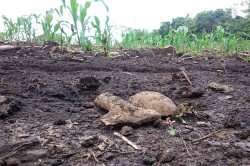Earthworms—integral ecosystem engineers

Global demands for food and energy are driving research on sustainably using our planet's fast-depleting natural resources. One creative initiative looked to ancient land-use systems that supported millions of people with no apparent negative effect on biodiversity and ecosystem resilience.
Amazonian dark earths (ADEs) is an ecosystem model based on sites with highly-nutrient-enriched soils and an outstanding capacity for sequestering carbon. Part of the EU-funded Marie Skłodowska-Curie Individual Fellowships, the HOOKaWORM project built on ADEs to advance a new model for ancient land use. "To gain insight into the ADE, a profoundly human-transformed ecosystem, the result of long-term human-environment interaction, we characterised the neglected soil biodiversity composition and activity of these soils," says project fellow Dr. Luis Cunha.
New tools for a new landscape reality
Marking the first-ever assessment of soil macrofauna in these particular soils, HOOKaWORM had to adopt and develop new methodologies and protocols and provide related training for the study of this landscape. "Most of the novelty in this project is directly linked with the deployment of genomics approaches to catalogue the full spectrum of earthworms and reveal how these animals interact to sustain the soils' properties," Dr. Cunha explains.
Results underline the persistence of historical soil enrichment after thousands of years, but contemporary land use drives nutrient decay and reduces biodiversity. "The findings support the idea that humans have built and sustained a contrasting highly fertile system and irreversibly altered the biodiversity patterns in Amazonia," Dr. Cunha states.
The contribution of soil biota to dark earths
Project partners successfully described 45 species of earthworms using molecular tools, some new to science. Their research shows that earthworms are one of the most important soil animals in ADEs. "The biological activity in soils was found to be significantly increased in ADEs, with a higher proportion of ecosystem-engineering animals, both in number and biomass," Dr. Cunha notes.
Such findings prompted the HOOKaWORM team to include these ecosystem engineers in an amended version of the accepted ADE model as they represent important functions in the genesis and nutrient cycling/resilience of ADE soils. The relevant work and proposed model is presented in the paper "Soil animals and pedogenesis: The role of earthworms in anthropogenic soils," published in Soil Science.
Understanding the past to plan a sustainable future
"The work in HOOKaWORM supports a vision where humans can be seen as niche constructors and where ancient people are recognised to know a lot about how to manage the natural resources that we have never considered before," Dr. Cunha underlines. This could potentially have far-reaching implications for indigenous communities in Amazonia. "Recognising the knowledge of the local people in how to manage forest resources would allow them to be at the table when decisions are made about tropical forests."
Another important HOOKaWORM outcome will ensure this work continues to impart local and global benefits. During the project, Dr. Cunha provided the impetus for creating an international collaborative network named Terra Preta de Índio, which translates to ADE or Indian black earth. Currently linking almost 100 researchers from 20 countries and 35 institutions, TPI members combine expertise in anthropology and archaeology with that of pedology, biogeochemistry and soil biology. The team, says Dr. Cunha, "is building a resilient scientific pathway, and will use novel technological approaches in future multifaceted projects to deliver far-reaching insights and impact." Three workshops have been organised since the TPI's establishment in 2015.
Future work is aimed at better understanding how soil enrichment practices in ADEs can support models of land-use intensification. Dr. Cunha also notes intentions to advance a technique for recovering exogenous DNA from soil samples. "This would be fruitful for any actions involving environmental monitoring and assessment of ecosystem health."
More information: Luis Cunha et al. Soil Animals and Pedogenesis, Soil Science (2016). DOI: 10.1097/SS.0000000000000144
Provided by CORDIS

















